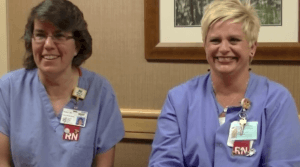 Here's the latest video in the series that Joe Swartz and I shot at Franciscan St. Francis Health back in October. See them all here or via a YouTube playlist.
Here's the latest video in the series that Joe Swartz and I shot at Franciscan St. Francis Health back in October. See them all here or via a YouTube playlist.
In this video, the endoscopy nurses who previously talked about how “the culture is staff input” are back to tell a story about their favorite Kaizen improvement.
I love this Kaizen example. It starts with identifying a problem that bothers and annoys patients. What's a simple way of making that better? At first, you might spend a little more money to improve the patient experience. Then, you might come up with a clever solution that then SAVES $30,000 a year while improving patient satisfaction (and keeping clinical outcomes the same).
People who are used to traditional suggestion box systems might ask, “How much of that savings was shared with the staff?” They aren't promised a percentage of cost savings. That gets VERY dysfunctional when you try to do that.
It's better to tap into the INTRINSIC motivation of staff. They want things to be easier and less frustrating. They want patients to be happier.
I asked them “what's in it for them?” Among other things that are based on intrinsic motivation and reasons why they wanted to become nurses…
“It's keeps patients from vomiting on me!”
It's really awesome to see this culture of continuous improvement in place. Don't you wish you could see this too? Oh, now you can!
New On-Site Workshop at Franciscan St. Francis Health
Not to “bury the lede,” but Joe Swartz and I are very excited to announce that we're going to pilot a new on-site workshop at the main Franciscan St. Francis hospital in Indianapolis, April 22 and 23.
It's going to be a day and a half of discussion, gemba visits, talks from managers and senior leaders, and a chance to see what a “culture of continuous improvement” really looks and feels like. I'll be there with Joe Swartz to help facilitate discussions and focus discussions on what YOU can do to repeat this success.
You can get 10% off as a “Lean Blog” reader. Use code “LEANBLOG” (available for the first 10 to register with this code). You're among the first to know about this workshop!
Video Transcripts:
Applesauce Kaizen
Julie: I did a Kaizen for manometries we would have to purchase. Our patients, when we put down a probe, it measures involuntary and voluntary muscle movements, and you have to kind of see if the muscles are functioning properly in the esophagus for certain patients to have certain types of hernia repairs or different types of surgeries. Then sometimes, patients have conditions where they can't swallow, so we're trying to figure out why.
The manometry part of it, you have to drink ten sips of Gatorade and there was this stuff that they used to use. It was a viscous, and basically, it was like, I don't know if I can say this, it's like flavored snot. So it was cherry, grape, and banana. I couldn't get patients had to swallow it most of the time.
Julie: You would get a 12-pack for $260 for the 12-pack. I would go through anywhere between one and two packs a week. Most of the time I was spending, what's $260 plus $260, five hundred and some-odd dollars a week on viscous for patients to swallow.
One day, I couldn't get the lady to swallow it. I was struggling, so I ran out here and I said, “Somebody please go get me some applesauce.” Let me see if she can swallow this. She did beautifully; it went down perfectly.
I called the company that the probe came from, and I said, “Can we use applesauce instead of viscous? Do I have to use it?” And they were like, “Well, no, as long as it didn't hurt the probe.” And I said, “No, it did fine.” We switched to applesauce, so that was a savings in two years of almost $30,000, just in the manometry program.
Rhonda: And the patients satisfaction?
Julie: The patients love it. It's so much easier; it goes down smoother. So that's it, and I didn't even think about implementing that, and I did that two years ago. Holland called me and said, “Did you just switch out applesauce for something?” And I said, “Yes.” She went, “That's a Kaizen, Julie.” Oh, OK. Well, I'll put it down. [laughs] Just something like that, that's the biggest Kaizen I've done.
Mark: Wow.
Julie: It's big savings, it's 30,000.
Mark: And other benefits, too. It's nice.
Julie: The patient benefits from it, too; applesauce throughout the hospital. Patients like it, its easy for us to get a hold of. If I run out of viscous, I would have to wait to order it or [inaudible 02:21] if I was going to be out, I might have like like three or four cases and then you'd have to have overnight shipping and stuff like that, so that's another expense. We don't have any of that expense any more.
Mark: That's great.
Julie: It slowly begins to make sense, like, “Well, gosh, just little changes can make big results.” I would have never thought applesauce. Not one time did I ever sit down and figure the numbers. Not one time until Holland said, “Can you figure those numbers up for me?” And I was like, “My goodness, that's huge!” Just something that small that's available for all of us to use.
Rhonda: When we tried to implement the applesauce, she was like, “Make sure the companies…don't go damage anything. And I was like, “Well, I don't freaking care.” But I can't say that she's ever pushed back and said, “I don't think that's a good idea.” No, “Try it and see if it works. If it doesn't work, we tried it.”
Julie: You've got a probe in your nose down into your stomach, and you're trying to eat and swallow all at the same time, let's make it as pleasant as possible. When I first starting doing it, they used salt water, and I'm like, “Why can't we just use Gatorade, something flavored?” So I did that, too.
[laughter and cross talk]
Rhonda: Another Kaizen.
Julie: Another Kaizen.
Mark: Well, keep doing them…
What's in it for you?
Mark Graban: I had someone ask yesterday, “Well, what happens if an employee comes up with an idea that saves the organization a lot of money? Applesauce is saving 30,000 a year. What's in it for the employee? Is it fair if the organization is getting benefits?”What's in it for the employee? Why do you participate in Kaizen? What's in it for you?
Rhonda: It's a better working environment, and your job's smoother and stuff. I don't even think of it as you should get anything else.
Julie: Yeah, it keeps patients from vomiting on me. [laughs]
Rhonda: It's pretty basic for her.
Julie: [laughs] That's basically why I came up with it. [laughs]
Mark: That sounds priceless.
Rhonda: Yes.
Julie: That is priceless. It's easier if people aren't throwing up on me all day.
Rhonda: Happier staff, happier patients, happier visitors.
Julie: Yeah, I mean I don't…
Rhonda: That's why we're nurses.
Julie: That's why we work here.
Julie: Honestly, that's why we work here. We all could go somewhere else. It's not a situation, “Well, I should get back from that.” I do get back from that. I get recognized for it. You know, Hollynn, Susan McRoberts. People said, “Hey, that's great.” We get recognized for it. If you were unhappy, you could always go somewhere else.
Please scroll down (or click) to post a comment. Connect with me on LinkedIn.
Let’s build a culture of continuous improvement and psychological safety—together. If you're a leader aiming for lasting change (not just more projects), I help organizations:
- Engage people at all levels in sustainable improvement
- Shift from fear of mistakes to learning from them
- Apply Lean thinking in practical, people-centered ways
Interested in coaching or a keynote talk? Let’s talk.
Join me for a Lean Healthcare Accelerator Trip to Japan! Learn More










